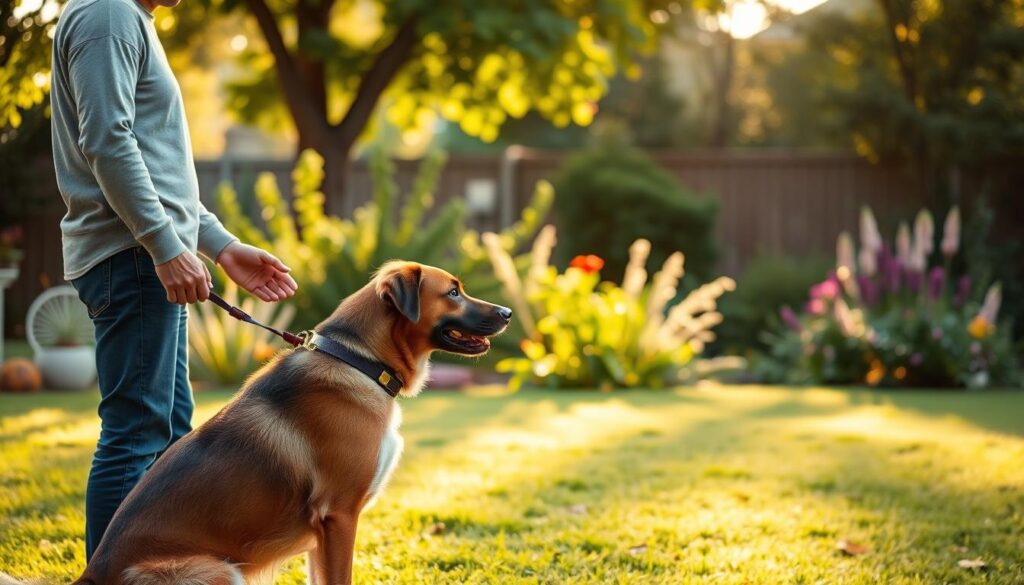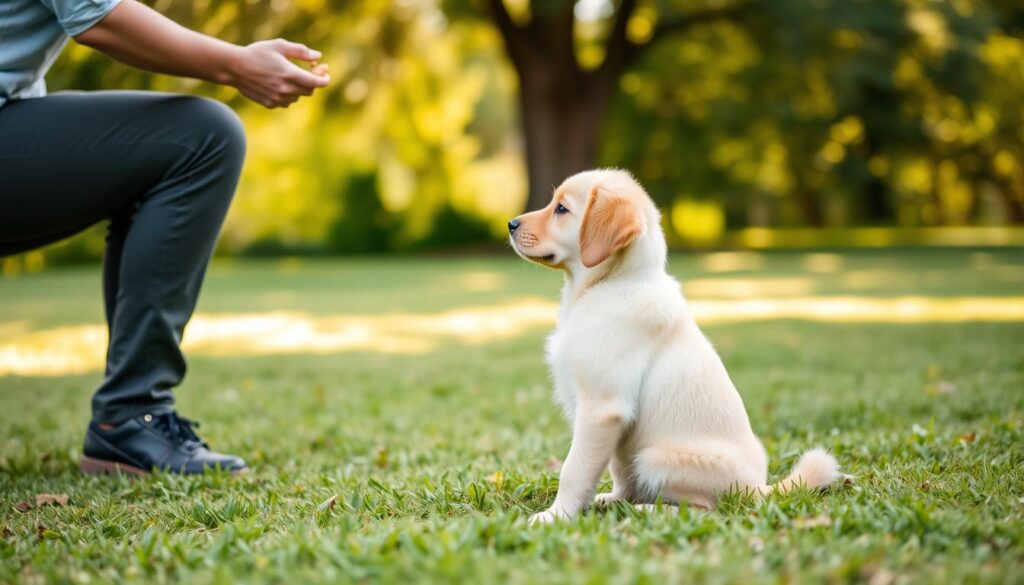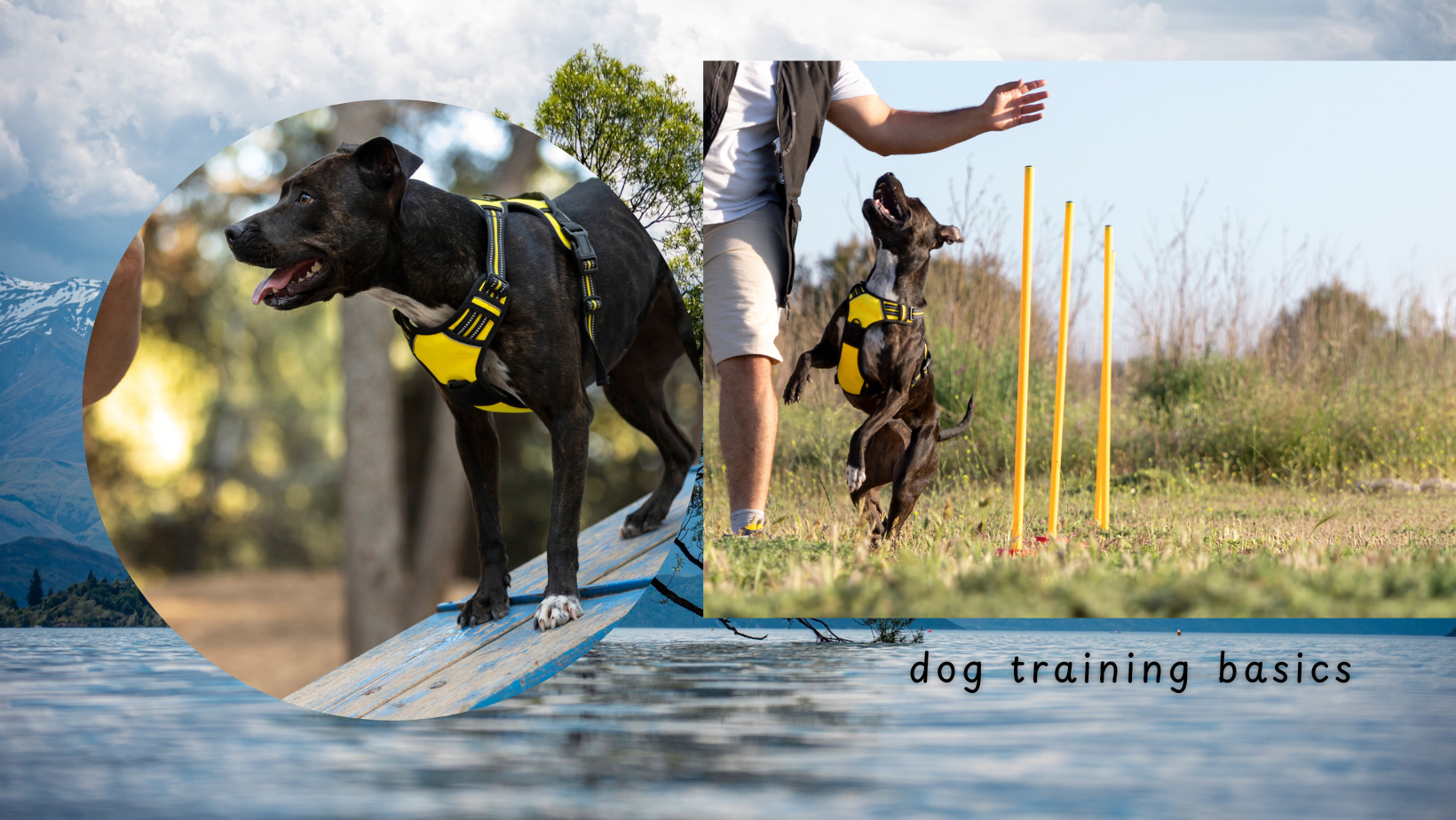Dog Training Basics: Why Positive Reinforcement Works Best
Welcome to your ultimate guide to dog training basics. This guide is perfect for new pet parents or those looking to improve their skills. It teaches the best dog training techniques to create a strong bond with your furry friend.
Proper obedience training for dogs is more than just commands. It’s about understanding your dog’s world. From teaching “sit” to managing behavior, this guide makes your journey fun and effective.
Every well-trained dog starts with the right foundation. The best dog training techniques use clear communication and positive reinforcement. This article shows you how to establish trust, decode your dog’s signals, and use proven methods for a happy, obedient companion.
You’ll also learn why patience and consistency are key. They are crucial for success in dog training.
Key Takeaways
- Master dog training basics to strengthen your dog’s obedience and safety.
- Observe how positive reinforcement shapes behavior better than punishment.
- Discover obedience training for dogs tailored to their instincts and needs.
- Learn to read body language to avoid misunderstandings during sessions.
- Apply the best dog training techniques to build lifelong trust and cooperation.
Understanding Your Dog’s Behavior: The Foundation of Training
Every wag, bark, or tilt of the head holds clues to your dog’s mind. Canine behavior training starts with decoding these signals. Dogs learn through social bonds formed with their pack—your family. Positive rewards and consistent cues form the bedrock of dog training basics.
How Dogs Learn and Communicate
Puppies observe and mimic, much like children. Reward-based methods strengthen desired actions. For example, a treat after “sit” reinforces the command. Key principles include:
- Association: Linking commands to actions
- Repetition: Practicing until behaviors become habits
- Pack dynamics: Dogs respond to calm, confident leadership
Reading Canine Body Language
A tucked tail signals fear; a relaxed wag shows happiness. Watch for:
- Ear position (perked up vs. flattened)
- Eye contact (direct gaze can mean dominance or play)
- Body posture (crouching may indicate submission)
“A wagging tail isn’t always happy—position matters,” say experts in animal behavior.
Breed-Specific Behavior Traits
Herding breeds like Border Collies thrive on mental challenges. Retrievers enjoy fetch-based lessons. Research your breed’s history—Labradors were bred to retrieve, making fetch ideal for training. This knowledge tailors canine behavior training to your dog’s natural instincts.
The Science Behind Effective Dog Training Basics
Effective dog training basics come from behavioral science. Dogs learn through associations and consequences. This is based on classical and operant conditioning.
Classical conditioning, like Pavlov’s experiments, shows how dogs link stimuli to rewards. Operant conditioning teaches how actions lead to outcomes, shaping behavior over time.
Operant conditioning has four key parts:
- Positive reinforcement (adding something pleasant, like treats when a dog sits).
- Negative reinforcement (removing something unpleasant, like easing leash tension when a dog walks calmly).
- Positive punishment (adding something aversive, which is rarely recommended).
- Negative punishment (removing something the dog wants, like ignoring bad behavior).
Experts say the best dog training techniques use positive reinforcement. It builds trust and speeds learning. Timing is key—rewards must follow desired behavior within seconds.
Habits form when behaviors are repeated consistently. Most commands take 3-6 weeks to stick, depending on the dog’s age and consistency. Patience and repetition turn new actions into automatic responses. Science shows rewards work better than punishment, fostering stronger human-animal bonds.
Essential Equipment for Training Success
Choosing the right tools is key for dog training basics. The right gear helps you communicate clearly without stressing your pet. Let’s explore must-have items to build a successful training toolkit.
Choosing the Right Collar and Leash
Collars and leashes are the foundation for control and comfort. Here’s what to consider:
| Type | Pros | Cons | Best For |
|---|---|---|---|
| Flat Collar | Comfortable, lightweight | Less control for strong dogs | Small breeds, basic walks |
| Martingale Collar | Prevents slipping, adjustable | Requires proper fit | Sighthounds, leash manners |
| Front-Clip Harness | Redirects pulling, secure | May take time to adjust | Pullers, large breeds |
Training Treats and Reward Systems
Choose treats that motivate without overfeeding. Try these tips:
- High-value treats: Small, smelly foods like chicken or cheese
- Low-value treats: Use for everyday sessions to avoid overstuffing
- Non-food rewards: Toys, belly rubs, or playtime for treat-averse dogs
Clickers and Other Training Tools
Clickers make clicker training for dogs fun. Follow these steps to start:
- Pair the click sound with a treat to create a positive association
- Click exactly when your dog performs the desired behavior
- Phase out treats gradually to focus on the click sound
Other tools like target sticks or training platforms can also help with advanced commands.
Always introduce tools gradually. Let your dog sniff or touch new items before use. Keep sessions fun to keep your pet eager to learn!
Establishing Leadership and Trust with Your Canine Companion
Effective dog training basics start with a partnership based on respect. Dogs do well when they see their owners as calm and consistent leaders. They need to trust their owners. Modern training focuses on clear communication, not dominance. This creates a safe space for your dog to follow your lead.
“Leadership isn’t about control—it’s about being a reliable guide your dog wants to follow.” — Certified Professional Dog Trainers Association

- Practice doorway waits: Have your dog sit before moving through doorways.
- Mealtime rules: Ask your dog to “sit” before placing food down.
- Leash focus: Walk calmly while your dog stays attentive to you, not distractions.
Building trust is key to a strong bond. Try these activities:
| Activity | How It Helps | Example |
|---|---|---|
| Interactive Play | Strengthens bond through shared fun | Fetch with a retrieve game |
| Calming Massage | Reduces anxiety and builds trust | Gentle petting focusing on paws and back |
| Training Games | Reinforces commands playfully | Hide-and-seek with a favorite toy |
Consistent routines and positive reinforcement are crucial. Dogs prefer teamwork over dictatorship. Every interaction in obedience training for dogs should show you’re a fair and approachable guide. With patience, your dog will see you as both leader and friend, leading to success.
Housebreaking Your Puppy: Patience and Consistency
Housebreaking a puppy needs routines that fit their growth. Start with a potty schedule based on age. Puppies under 12 weeks need bathroom breaks every 1-2 hours, after meals and naps. A consistent routine helps them learn where to go. Keep these puppy training tips in mind:
- Watch for signs like sniffing or circling—this means “I need to go!”
- Choose a specific exit for outdoor trips to build associations
- Reward successes with treats and praise immediately
Creating an Effective Potty Schedule
Use a printable schedule template to track meals, playtime, and potty breaks. Adjust as your puppy grows. For instance:
- After waking: Take to designated spot
- After eating: Wait 30 minutes before outdoor break
- Every 2 hours during awake time
Managing Accidents Constructively
If an accident happens, stay calm. Clean thoroughly with enzymatic cleaners to remove odors. Avoid scolding—puppies don’t understand punishment. Instead:
- Isolate soiled areas temporarily
- Reinforce the potty spot with positive reinforcement
- Consult a vet if accidents persist
Transitioning to Outdoor Relief
Begin by moving the indoor potty area closer to the door each day. For apartment living, use positive leash walks to the balcony or a nearby park. In cold climates, invest in a heated dog bed near the door to keep paws warm during breaks.
Mastering Leash Training for Dogs of All Ages
Leash training is key for dog training basics. Begin by letting your puppy sniff a collar and leash at home. This helps them associate these items with positive experiences through treats. For older dogs, be patient. Don’t force walks until they’re ready.
- Begin with 2-3 minute sessions in low-distraction areas.
- Reward small steps: a glance at you, a step beside you.
- Pause and retreat if your dog pulls—teach “Let’s go” as a cue to re-engage.
If your dog lunges or freezes, try using hand signals or a favorite toy to redirect their attention. Avoid retractable leashes as they encourage pulling. Instead, use a front-clip harness or head halter to guide them gently.
“Leash pressure should never replace communication. A tight leash is a training breakdown,” says certified trainer Sarah Collins.
Practice U-turns when your dog pulls ahead, rewarding them for walking calmly. Use verbal praise, not just treats, during walks. Remember, progress is not always steady. Celebrate small victories, like when your dog stays close for 10 seconds. Consistency over time builds strong habits.
When going outside, start in quiet parks and gradually add distractions like passing bikes or other dogs. Always check the leash for safety. With time, walks become a way to bond, not a struggle.
Positive Reinforcement Training: Why It Works
Positive reinforcement training rewards good behavior, strengthening your bond with your dog. It uses clear, kind guidance that boosts confidence, not fear. This approach leads to lasting results.
The Power of Praise and Rewards
Dogs respond to different rewards like treats, play, or affection. Find out what your dog loves most. Then, reward them right when they do something good.
As they learn, start using less treats and more praise. Being consistent helps them understand the connection between their actions and rewards.
Clicker Training for Precise Communication
Clicker training helps you mark the exact moment of good behavior. Here’s how to do it:
- Charge the clicker: Make your dog associate its sound with rewards by pairing it with treats.
- Click and reward when they do something right, like sitting or staying calm.
- Once they learn, add more commands to their routine.
Avoiding Punishment-Based Methods
“Punishment suppresses behavior temporarily but damages trust.”
Research shows harsh methods can make dogs anxious and aggressive. Positive reinforcement builds trust and cooperation without fear. Instead of scolding, use commands like “leave it” to redirect unwanted behavior.
Science backs up positive training methods. They create a happy learning experience for both you and your dog.
Teaching Basic Commands: Sit, Stay, Come, and More
Learning basic commands is crucial for a safe and happy bond with your dog. obedience training for dogs is simple and accessible. Follow these best dog training techniques to lay a solid foundation:

- Sit: Hold a treat near your dog’s nose, then move your hand up. When their bottom touches the floor, say “sit” and give them the treat.
- Stay: Begin with “sit,” then hold your hand out while saying “stay.” Give them a treat for staying still, then gradually increase the distance and time.
- Come: Call your dog with a happy voice while crouching. Give them a treat right away. Start in quiet areas first.
| Command | Teaching Phase | Strengthening Phase | Proofing Phase |
|---|---|---|---|
| Sit | Treat lure | Hand signal alone | Busy environments |
| Stay | 3-second holds | 10-second holds | With distractions |
| Come | Leash-guided practice | Off-leash in yard | Park or outside |
For dogs that are hard to train, try combining different methods like luring and capturing. If your dog doesn’t come when called, here are some tips:
- Never call and scold
- Use high-value treats
- Practice only when relaxed
“A reliable recall saves lives. Always reward coming with enthusiasm!”
Consistency is key. Use the same commands and gestures with everyone in the family. Start with simple commands like “sit” and then move on to more complex ones like “heel.” Celebrate every small success—your dog’s learning journey is a journey of patience and praise.
Addressing Common Behavior Problems: From Jumping to Barking
Every dog faces behavior challenges, but most can be solved with the right puppy training tips and canine behavior training. Let’s look at solutions for three common problems using patience and positive strategies.
Managing Excessive Barking
Barking often means a dog needs something. First, find out what triggers it:
- Alarm barking: Help dogs get used to sounds like doorbells with slow exposure and treats.
- Attention-seeking barks: Ignore the noise and praise them when they’re quiet.
- Boredom: Give them more exercise and fun toys to keep them busy.
Preventing Destructive Chewing
Change chewing habits with these tips:
| Problem Behavior | Solution |
|---|---|
| Destroying shoes | Give them tough chew toys like KONG or Nylabone |
| Separation chewing | Leave puzzle toys with treats when you’re away |
| Attention-seeking chewing | Teach “leave it” and give them approved items |
Stopping Jumping on People
Jumping is often due to excitement. Here’s how to handle it:
- Turn away when they jump on you. Ignore them until they’re calm.
- Give them treats and praise when they greet calmly.
- Practice with visitors to keep it consistent.
Changing behavior takes time. Celebrate small victories and keep up the effort. Every challenge is a chance to grow closer to your dog!
Conclusion: Building a Lifelong Training Relationship with Your Dog
Training your dog is a journey that needs patience and consistency. The best methods use positive reinforcement, making every moment special. Teaching your dog to sit or stopping barking helps you bond.
Dogs do well with routines and rewards. Use treats, praise, and clear cues to help them learn. As they grow, try new things like agility classes. The American Kennel Club and local clubs can help you find new activities.
Setbacks are normal in training. If your dog misbehaves, don’t worry. Stay calm, go back to lessons, and celebrate small wins. This builds a confident dog and a stronger bond between you.
Your dedication builds a lifetime of trust. Using positive methods makes your dog feel safe and valued. Every training session, big or small, strengthens your bond and joy.
Training isn’t just about finishing a list. It’s about supporting your dog’s happiness and yours. Keep learning, be flexible, and let curiosity lead. Together, you’ll make every day special.

